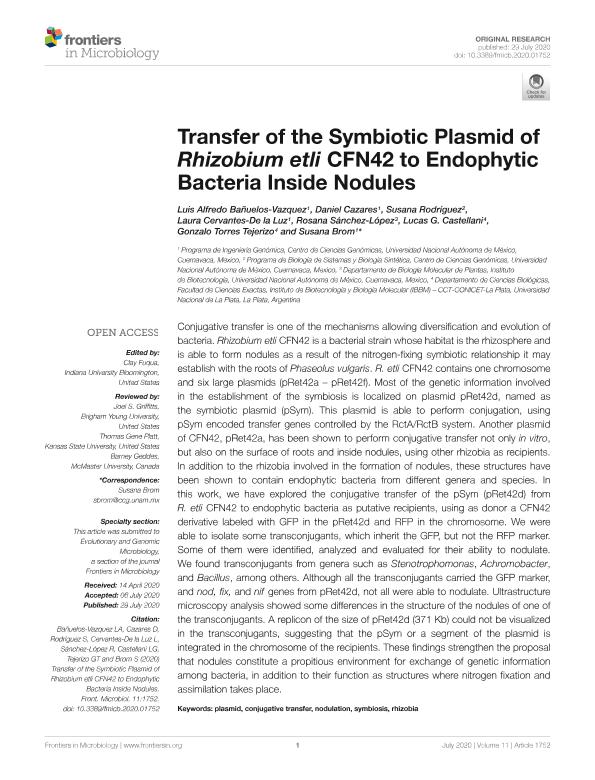Mostrar el registro sencillo del ítem
dc.contributor.author
Bañuelos Vazquez, Luis Alfredo
dc.contributor.author
Cazares, Daniel
dc.contributor.author
Rodríguez, Susana
dc.contributor.author
Cervantes De la Luz, Laura
dc.contributor.author
Sánchez López, Rosana
dc.contributor.author
Castellani, Lucas Gabriel

dc.contributor.author
Torres Tejerizo, Gonzalo Arturo

dc.contributor.author
Brom, Susana
dc.date.available
2022-04-22T20:38:16Z
dc.date.issued
2020-07-29
dc.identifier.citation
Bañuelos Vazquez, Luis Alfredo; Cazares, Daniel; Rodríguez, Susana; Cervantes De la Luz, Laura; Sánchez López, Rosana; et al.; Transfer of the symbiotic plasmid of rhizobium etli CFN42 to endophytic bacteria inside nodules; Frontiers Media; Frontiers in Microbiology; 11; 29-7-2020; 1-13
dc.identifier.uri
http://hdl.handle.net/11336/155640
dc.description.abstract
Conjugative transfer is one of the mechanisms allowing diversification and evolution ofbacteria. Rhizobium etli CFN42 is a bacterial strain whose habitat is the rhizosphere andis able to form nodules as a result of the nitrogen-fixing symbiotic relationship it mayestablish with the roots of Phaseolus vulgaris. R. etli CFN42 contains one chromosomeand six large plasmids (pRet42a ? pRet42f). Most of the genetic information involvedin the establishment of the symbiosis is localized on plasmid pRet42d, named asthe symbiotic plasmid (pSym). This plasmid is able to perform conjugation, usingpSym encoded transfer genes controlled by the RctA/RctB system. Another plasmidof CFN42, pRet42a, has been shown to perform conjugative transfer not only in vitro,but also on the surface of roots and inside nodules, using other rhizobia as recipients.In addition to the rhizobia involved in the formation of nodules, these structures havebeen shown to contain endophytic bacteria from different genera and species. Inthis work, we have explored the conjugative transfer of the pSym (pRet42d) fromR. etli CFN42 to endophytic bacteria as putative recipients, using as donor a CFN42derivative labeled with GFP in the pRet42d and RFP in the chromosome. We wereable to isolate some transconjugants, which inherit the GFP, but not the RFP marker.Some of them were identified, analyzed and evaluated for their ability to nodulate.We found transconjugants from genera such as Stenotrophomonas, Achromobacter,and Bacillus, among others. Although all the transconjugants carried the GFP marker,and nod, fix, and nif genes from pRet42d, not all were able to nodulate. Ultrastructuremicroscopy analysis showed some differences in the structure of the nodules of one ofthe transconjugants. A replicon of the size of pRet42d (371 Kb) could not be visualizedin the transconjugants, suggesting that the pSym or a segment of the plasmid isintegrated in the chromosome of the recipients. These findings strengthen the proposalthat nodules constitute a propitious environment for exchange of genetic informationamong bacteria, in addition to their function as structures where nitrogen fixation andassimilation takes place
dc.format
application/pdf
dc.language.iso
eng
dc.publisher
Frontiers Media

dc.rights
info:eu-repo/semantics/openAccess
dc.rights.uri
https://creativecommons.org/licenses/by/2.5/ar/
dc.subject
PLASMID
dc.subject
ENDOPHYTIC
dc.subject
NODULE
dc.subject.classification
Biología Celular, Microbiología

dc.subject.classification
Ciencias Biológicas

dc.subject.classification
CIENCIAS NATURALES Y EXACTAS

dc.title
Transfer of the symbiotic plasmid of rhizobium etli CFN42 to endophytic bacteria inside nodules
dc.type
info:eu-repo/semantics/article
dc.type
info:ar-repo/semantics/artículo
dc.type
info:eu-repo/semantics/publishedVersion
dc.date.updated
2021-09-06T17:48:08Z
dc.identifier.eissn
1664-302X
dc.journal.volume
11
dc.journal.pagination
1-13
dc.journal.pais
Suiza

dc.description.fil
Fil: Bañuelos Vazquez, Luis Alfredo. Universidad Nacional Autónoma de México; México
dc.description.fil
Fil: Cazares, Daniel. Universidad Nacional Autónoma de México; México
dc.description.fil
Fil: Rodríguez, Susana. Universidad Nacional Autónoma de México; México
dc.description.fil
Fil: Cervantes De la Luz, Laura. Universidad Nacional Autónoma de México; México
dc.description.fil
Fil: Sánchez López, Rosana. Universidad Nacional Autónoma de México; México
dc.description.fil
Fil: Castellani, Lucas Gabriel. Consejo Nacional de Investigaciones Científicas y Técnicas. Centro Científico Tecnológico Conicet - La Plata. Instituto de Biotecnología y Biología Molecular. Universidad Nacional de La Plata. Facultad de Ciencias Exactas. Instituto de Biotecnología y Biología Molecular; Argentina
dc.description.fil
Fil: Torres Tejerizo, Gonzalo Arturo. Consejo Nacional de Investigaciones Científicas y Técnicas. Centro Científico Tecnológico Conicet - La Plata. Instituto de Biotecnología y Biología Molecular. Universidad Nacional de La Plata. Facultad de Ciencias Exactas. Instituto de Biotecnología y Biología Molecular; Argentina
dc.description.fil
Fil: Brom, Susana. Universidad Nacional Autónoma de México; México
dc.journal.title
Frontiers in Microbiology
dc.relation.alternativeid
info:eu-repo/semantics/altIdentifier/url/https://www.frontiersin.org/article/10.3389/fmicb.2020.01752/full
dc.relation.alternativeid
info:eu-repo/semantics/altIdentifier/doi/http://dx.doi.org/10.3389/fmicb.2020.01752
Archivos asociados
